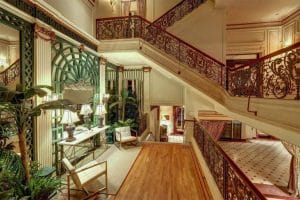
Many major art and design movements arrive on the scene with a bang—they are disruptive, brought to light by risk takers who question the status quo. Others blossom more slowly, coming to fruition after much trial and error. And throughout the 20th and 21st centuries, there have been a handful of visual art and design movements that changed the way we think about architecture, style, and esthetics. The painters, designers, and sculptors of these movements challenged traditional forms, using materials and technology in unconventional and new ways. A reflection of the social, political, and economic times in which they emerged, these design epiphanies changed the landscape for architecture and interior design forever.
Medieval Craftsmanship Deserves a Second Look: The Arts and Crafts Movement, 1850–1914

A reaction against the industrial revolution and mass production, the Arts and Crafts movement spread across Europe during the second half of the 19th century. The decline of craftsmanship during the period was much lamented, spurring a renewed interest in the decorative arts. One of the primary figures associated with Arts and Crafts is William Morris, a poet and designer who formed a collective of artists during the 1860s who were interested in reinvigorating the handcrafted esthetics of the medieval period. The group created textiles, wallpaper, metalwork, and other finely-detailed materials, and by 1875 they became known as Morris and Company. Their design practices and philosophies became incredibly influential for the next generation of designers, despite criticisms that the movement was exclusionary and impractical.
Natural Shapes Belong Indoors: Art Nouveau, 1880–1910

Stemming from the Arts and Crafts movement that came before it, Art Nouveau emphasized the ornamental. The use of organic shapes and asymmetrical lines appeared in jewelry, architecture, and print material, contrasting with the angular lines of mass-produced products. Meaning “New Art,” the movement continued to react against the industrialization and mechanization of the late 20th and early 21st centuries; curves and flowing shapes mimic the plants, vines, and stems of the natural world. A major figure in the movement, Emile Galle was a French artist who worked primarily with glass. Because of his involvement, the movement is closely associated with French design and appears in iconic architectural details, including the entrances to the Paris Métro.
Simplicity is Beautiful: Bauhaus,1919–1933

Founded by Walter Gropius in Germany, the Bauhaus Design School was established with the intention of moving away from the student-teacher model and encouraging communal instruction. One of the major tenets of the movement was simplifying design and function; the sans-serif font was born out of the movement, a contrast to the serif fonts beings used in Germany at the time. Distinctive features of Bauhaus include curved steel, geometric shapes, sharp angles, and monochromatic colours. The Bauhaus School was disbanded in 1933 due to pressures from the Nazis, but the philosophy of functional and straightforward design continued to influence artists and designers for generations to follow, and was a major springboard for Modernism.
Urban Optimism in All Things: Art Deco, 1920–1939

As skyscrapers began to change the face of cities across the world, they heralded in a new wave of city-influenced design. Cruise liners and planes became more accessible to the average person, Tutankhamun’s tomb was discovered, and technological advances lead to even more mass production. This economic boom and interest in global affairs was reflected in the era’s art and architecture. Taking cues from the Art Nouveau, Bauhaus, and Cubism movements, Art Deco communicated design through streamlined shapes and geometric ornamentation. Materials including chrome, satin, and high-gloss wood was used in everything from lamps to table-top clocks to furniture, and geometric, highly symmetrical patterns reigned supreme.
Pare Back to Uncover the Essential: Minimalism, Late 1960s

This movement originated in New York in the late 1960s and was typified by extreme simplicity and literal, objective approaches to art and design. Major figures in the minimalist art movement include Donald Judd, Dan Flavin, and Sol LeWitt. The minimalist artists believed that art should not refer to anything other than itself, and many of their philosophies about two-dimensionality and literal objectivism were a reaction against the earlier Abstract Expressionist movement. Minimal painting is typified by hard-edged lines and flat surfaces, while minimal sculpture generally consists of extremely simple forms in materials like fibreglass or metal, though usually monumental in size. The non-referential qualities of minimal art are an attempt to explore the essential elements of design and construction.
Reach for the Iconic: Pop Art, 1950s–1970s

As is a common theme in art history, groundbreaking change occurs when a group of artists create work that questions or rejects traditional views of design. Such is the case with Pop Art. The colorful, irreverent movement that emerged with a focus on material culture over the Abstract Expressionism that was popular in the day, while taking a different tack to the minimalist movement. For Pop Art, everything deserves a place. First named by artists in the Independent Group out of London’s Institute of Contemporary Art and spearheaded in the United States by practitioners including Andy Warhol and Roy Lichtenstein, Pop Art presented celebrity, newspapers, comic books, and consumer goods as celebration. The result was an artistic ethos that held a mirror up to the society of the day, regardless of whether the results complied with the tenets of good taste. As Warhol is credited with claiming, “Everything is beautiful. Pop is everything.”
Whether movements build off of one another to create something new, or reject previous esthetics entirely, groundbreaking design is inevitably a sign of the times. Style epiphanies are tied to their times, full of contextual zeitgeist: the “spirit of the age.” Change is often ushered in by the artists who question the conventional and disrupt the way we think about design—sometimes with a lasting, far-reaching impact.
Dive further into home design and browse these timeless custom listings.
POSTED WITH PERMISSION. COPYRIGHT SOTHEBY’S INTERNATIONAL REALTY. Click to read original article.

